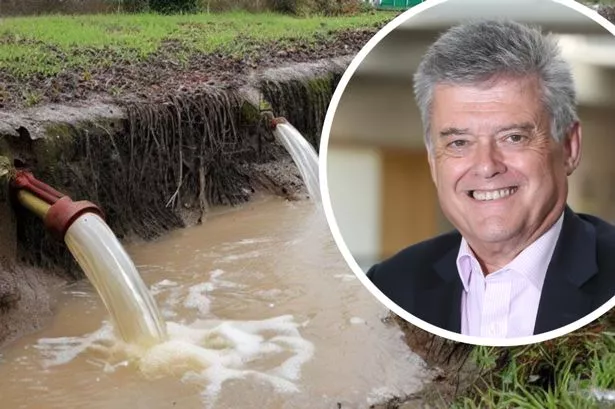A fierce row has erupted between the West of England's metro mayor Dan Norris and the boss of Wessex Water after the mayor accused the water company of ‘acting like rogue traders’ over the issue of sewage being released into rivers in the region.
Colin Skellett, who has run Wessex Water for more than 30 years and continued in post after it was bought by Malaysian company YTL in 2002, counter-accused Mr Norris of not ‘checking his facts’, after the Labour metro mayor criticised Wessex Water over large increases in the amount of sewage that ended up in the region's rivers last year.
The Environment Agency has now released the latest figures for 2023 which detail the number of times in a year that sewage was allowed to flow from water companies’ sewage systems into rivers and streams, and for how long that happened each time. And those figures showed the number of incidents reported by the EA in the Wessex Water area had almost doubled, and the total amount of time sewage overflowed into the rivers and streams almost tripled.
Read next: Government issues major warning to West of England leaders
Read more: Two years until Bristol finally gets an arena - but the end is in sight
The Environment Agency figures showed the total number of sewage spill incidents from Wessex Water’s monitored storm overflows was 21,878 in 2022, but had increased to 41,453 in 2023. The average number of times each storm overflow had to be used to allow sewage to flow into rivers and streams in Wessex Water’s area was 23 times a year in 2022 but that rose to 33 times a year in 2023.
And the length of time those sewage overflow incidents occurred also increased - which meant that not only did the number of times the storm overflows were opened to allow sewage to flow into the river increase, but the length of time each one was open for also increased. In 2022, each incident lasted for an average of 3.4 hours, but that increased to 5.6 hours last year.
That meant the total period that Wessex Water allowed sewage to flow into rivers increased hugely in the past year. In 2022, it happened for 129,957 hours in total, but that rose to 372,341 hours in 2023. Wessex Water said the big increases were down to 2023 being the second wettest year on record, and also because many more of its overflow outlets are now monitored, so the figures were bound to appear worse.
But the Environment Agency data sparked Labour metro mayor Dan Norris to issue a blistering attack on Wessex Water, calling on the Government to hold Wessex Water and other companies ‘to account’ for this. “These disturbing new findings are a damning indictment of 14 years of government failure to hold water companies to account,” he said.
“It is time water bosses are held legally and financially accountable for allowing our rivers and lakes to become sewage-infested messes. And we’ve got to toughen up regulations that allow the system to be abused, and water firms to go around acting like rogue traders.
“The next Labour government will end the Tory sewage scandal for good,” he added.

As part of a West of England metro mayor statement on the issue, a spokesperson added: “Not a not a single stretch of river in the West of England is in ‘good’ overall health - including Wellow Brook just off Radstock, Bradley Brook near Bristol and Laddon Brook just off Yate which have all been classified as being in ‘poor’ health - according to a Rivers Trust report last month.
“Dan Norris is doing everything he can at a regional level to clean up the mess created by the current government, including funding a suspended floating plant system to help fish and rare eels at the new Capricorn Quay, but urged ministers to play their part in fixing the "crisis" affecting the region's rivers and lakes,” he said.
The attack sparked a furious response from Wessex Water. A spokesperson explained that the sewage discharges were a last result in times of heavy rain to stop sewage backing up and flooding people’s homes, when the storm drain system can’t cope with the amount of rainfall.

“Storm overflow discharges increased last year due to exceptionally wet weather, preventing properties from flooding,” he said. “Hundreds of these overflows are affected by groundwater, with tests showing these discharges are cleaner than the standards set for treated sewage discharges.
“While overflows are licensed to operate automatically, we agree they aren’t fit for purpose in a 21st century sewerage system and are currently spending £3 million a month to progressively improve them – with plans to more than double that investment if approved by our regulators,” he added.
The naming of three rivers in the West of England region that were of ‘poor health’ according to the Environment Agency also prompted a response from Wessex Water, with a spokesperson pointing out that the Environment Agency itself said that the poor quality of the Laddon Brook and Bradley Brook wasn’t down to Wessex Water’s sewage storm overflow discharges anyway.
The firm’s chief executive, Colin Skellett, described Mr Norris’s intervention in the ongoing debate around water quality and sewage in rivers as ‘concerning’. In an email to Mr Norris, seen by Bristol Live, Mr Skellett called on the metro mayor to ‘correct the misleading impression’ his words were giving.

“It's a pity you did not contact us to check the facts,” the chief executive told Mr Norris. “The Environment Agency’s data indicates that storm overflows contribute to just 3 per cent of the reasons that the Bristol Avon catchment does not achieve good ecological status, well below factors such as urban runoff (31 per cent) and agriculture (25 per cent).
“Specifically, for the Ladden Brook, the EA report the cause as agriculture, for the Bradley Brook, the cause is urban runoff, transport, mining and quarrying and only for the Wellow Brook is sewage a contributing factor. Work has already begun to improve treatment that impacts on the brook.
“Storm overflow discharges did increase across England in 2023 because it was the fourth wettest year since records began. There are now monitors installed on 100 per cent of storm overflows in the country, so discharge figures would likely be higher in 2023 even if rainfall wasn’t as high.
“Despite their minimal environmental impact, Wessex Water agrees that storm overflows are outdated. This is why we are investing £3 million a month to progressively improve them – with plans to more than double this between 2025 and 2030, subject to regulators’ approval.
"For the River Avon catchment, several projects are underway to reduce the operation of storm overflows that discharge most frequently,” he added, listing multi-million work to improve the sewage network in Saltford, Keynsham, Lambridge, near Bath, Hanham and Bradford-on-Avon in Wiltshire.
“Additionally, work is taking place around the Wessex Water region to separate rainwater from sewage, seal sewers to prevent groundwater infiltration, and construct wetlands to improve the quality of discharges both from storm overflows and treatment sites,” he added. “I hope you will correct the misleading impression that your comments give,” Mr Skellett said.




















